OFFICIAL iBT Test (Volume 1) - Test 1
READING
This section measures your ability to understand academic passages in English.
There are three passages in the section. Give yourself 18 minutes to read each passage and answer the questions about it. The entire section will take 54 minutes to complete.
You may look back at a passage when answering the questions. You can skip questions and go back to them later as long as there is time remaining.
Directions: Read the passage. Then answer the questions. Give yourself 18 minutes to complete this practice set.
DEER POPULATIONS OF THE PUGET SOUND
Two species of deer have been prevalent in the Puget Sound area of Washington state in the Pacific Northwest of the United States. The black- tailed deer, a lowland, west-side cousin of the mule. deer of eastern Washington, is now the most common. The other species, the Columbian white-tailed deer, in earlier times was common in the open prairie country; it is now restricted to the low, marshy islands and flood plains along the lower Columbia River.
Nearly any kind of plant of the forest understory can be part of a deer’s diet. Where the forest inhibits the growth of grass and other meadow plants, the black-tailed deer browses on huckleberry, salal, dogwood, and almost any other shrub or herb. But this is fair-weather feeding. What keeps the black- tailed deer alive in the harsher seasons of plant decay and dormancy? One compensation for not hibernating is the built-in urge to migrate. Deer may move from high-elevation browse areas in summer down to the lowland areas in late fall. Even with snow on the ground, the high bushy understory is exposed; also snow and wind bring down leafy branches of cedar, hemlock, red alder, and other arboreal fodder.
The numbers of deer have fluctuated markedly since the entry of Europeans into Puget Sound country. The early explorers and settlers told of abundant deer in the early 1800s and yet almost in the same breath bemoaned the lack of this succulent game animal. Famous explorers of the North American frontier, Lewis and Clark arrived at the mouth of the Columbia River on November 14, 1805, in nearly starved circumstances. They had experienced great difficulty finding game west of the Rockies and not until the second of December did they kill their first elk. To keep. 40 people alive that winter, they consumed approximately 150 elk and 20 deer. And when game moved out of the lowlands in early spring, the expedition decided to return east rather than face. possible starvation. Later on in the early years of the nineteenth century, when Fort Vancouver became the headquarters for the Hudson’s Bay Company, deer populations continued to fluctuate. David Douglas, Scottish botanical explorer of the 1830s, found a disturbing change in the animal life around the fort during the period between his first visit in 1825 and his final contact with the fort in 1832. A recent Douglas biographer states: “The deer which once picturesquely dotted the meadows around the fort were gone [in 1832], hunted to extermination in order to protect the crops.”
Reduction in numbers of game should have boded ill for their survival in later times. A worsening of the plight of deer was to be expected as settlers encroached on the land, logging, burning, and clearing, eventually replacing a wilderness landscape with roads, cities, towns, and factories. No doubt the numbers of deer declined still further. Recall the fate of the Columbian white- tailed deer, now in a protected status. But for the black-tailed deer, human pressure has had just the opposite effect. Wildlife zoologist Helmut Buechner (1953), in reviewing the nature of biotic changes in Washington through recorded time, says that “since the early 1940s, the state has had more deer than at any other time in its history, the winter population fluctuating around approximately 320,000 deer (mule and black-tailed deer), which will yield about 65,000 of either sex and any age annually for an indefinite period.”
The causes of this population rebound are consequences of other human actions. First, the major predators of deer—wolves, cougar, and lynx—have been greatly reduced in numbers. Second, conservation has been insured by limiting times for and types of hunting. But the most profound reason for the restoration of high population numbers has been the fate of the forests. Great tracts of lowland country deforested by logging, fire, or both have become ideal feeding grounds for deer. In addition to finding an increase of suitable browse, like huckleberry and vine maple, Arthur Einarsen, longtime game biologist in the Pacific Northwest, found quality of browse in the open areas to be substantially more nutritive. The protein content of shade-grown vegetation, for example, was much lower than that for plants grown in clearings.
Directions: Now answer the questions.
PARAGRAPH 1
Two species of deer have been prevalent in the Puget Sound area of Washington state in the Pacific Northwest of the United States. The black- tailed deer, a lowland, west-side cousin of the mule deer of eastern Washington, is now the most common. The other species, the Columbian white-tailed deer, in earlier times was common in the open prairie country; it is now restricted to the low, marshy islands and flood plains along the lower Columbia River.
1. According to paragraph 1, which of the following is true of the white- tailed deer of Puget Sound?
A. It is native to lowlands and marshes.
B. It is more closely related to the mule deer of eastern Washington than to other types of deer.
C. It has replaced the black-tailed deer in the open prairie.
D. It no longer lives in a particular type of habitat that it once occupied.
PARAGRAPH 2
Nearly any kind of plant of the forest understory can be part of a deer’s diet. Where the forest inhibits the growth of grass and other meadow plants, the black-tailed deer browses on huckleberry, salal, dogwood, and almost any other shrub or herb. But this is fair-weather feeding. What keeps the black- tailed deer alive in the harsher seasons of plant decay and dormancy? One compensation for not hibernating is the built-in urge to migrate. Deer may move from high-elevation browse areas in summer down to the lowland areas in late fall. Even with snow on the ground, the high bushy understory is exposed; also snow and wind bring down leafy branches of cedar, hemlock, red alder, and other arboreal fodder.
2. It can be inferred from the discussion in paragraph 2 that winter conditions
A. cause some deer to hibernate
B. make food unavailable in the highlands for deer
C. make it easier for deer to locate understory plants
D. prevent deer from migrating during the winter
PARAGRAPH 3
The numbers of deer have fluctuated markedly since the entry of Europeans into Puget Sound country. The early explorers and settlers told of abundant deer in the early 1800s and yet almost in the same breath bemoaned the lack of this succulent game animal. Famous explorers of the North American frontier, Lewis and Clark arrived at the mouth of the Columbia River on November 14, 1805, in nearly starved circumstances. They had experienced great difficulty finding game west of the Rockies and not until the second of December did they kill their first elk. To keep 40 people alive that winter, they consumed approximately 150 elk and 20 deer. And when game moved out of the lowlands in early spring, the expedition decided to return east rather than face possible starvation. Later on in the early years of the nineteenth century, when Fort Vancouver became the headquarters for the Hudson’s Bay Company, deer populations continued to fluctuate. David Douglas, Scottish botanical explorer of the 1830s, found a disturbing change in the animal life around the fort during the period between his first visit in 1825 and his final contact with the fort in 1832. A recent Douglas biographer states: “The deer which once picturesquely dotted the meadows around the fort were gone [in 1832], hunted to extermination in order to protect the crops.”
3. The author tells the story of the explorers Lewis and Clarkin paragraph 3 in order to illustrate which of the following points?
A. The number of deer within the Puget Sound region has varied over time.
B. Most of the explorers who came to the Puget Sound area were primarily interested in hunting game.
C. There was more game for hunting in the East of the United States than in the West.
D. Individual explorers were not as successful at locating game as were the trading companies.
4. According to paragraph 3, how had Fort Vancouver changed by the time David Douglas returned in 1832?
A. The fort had become the headquarters for the Hudson’s Bay Company.
B. Deer had begun populating the meadows around the fort.
C. Deer populations near the fort had been destroyed.
D. Crop yields in the area around the fort had decreased.
PARAGRAPH 4
Reduction in numbers of game should have boded ill for their survival in later times. A worsening of the plight of deer was to be expected as settlers encroached on the land, logging, burning, and clearing, eventually replacing a wilderness landscape with roads, cities, towns, and factories. No doubt the numbers of deer declined still further. Recall the fate of the Columbian white-tailed deer, now in a protected status. But for the black-tailed deer, human pressure has had just the opposite effect. Wildlife zoologist Helmut Buechner (1953), in reviewing the nature of biotic changes in Washington through recorded time, says that “since the early 1940s, the state has had more deer than at any other time in its history, the winter population fluctuating around approximately 320,000 deer (mule and black-tailed deer), which will yield about 65,000 of either sex and any age annually for an indefinite period.”
5. Why does the author ask reader store call “the fate of the Columbian white-tailed deer” in the discussion of changes in the wilderness landscape?
A. To provide support for the idea that habitat destruction would lead to population decline
B. To compare how two species of deer caused biotic changes in the wilderness environment
C. To provide an example of a species of deer that has successfully adapted to human settlement
D. To argue that some deer species must be given a protected status
6. The phrase “indefinite period” in the passage is closest in meaning to a period
A. whose end has not been determined
B. that does not begin when expected
C. that lasts only briefly
D. whose importance remains unknown
7. Which of the following statements about deer populations is supported by the information in paragraph 4?
A. Deer populations reached their highest point during the 1940s and then began to decline.
B. The activities of settlers contributed in unexpected ways to the growth of some deer populations in later times.
C. The clearing of wilderness land for construction caused biotic changes from which the black-tailed deer population has never recovered.
D. Since the 1940s the winter populations of deer have fluctuated more than the summer populations have.
PARAGRAPH 5
The causes of this population rebound are consequences of other human actions. First, the major predators of deer—wolves, cougar, and lynx—have been greatly reduced in numbers. Second, conservation has been insured by limiting times for and types of hunting. But the most profound reason for the restoration of high population numbers has been the fate of the forests. Great tracts of lowland country deforested by logging, fire, or both have become ideal feeding grounds for deer. In addition to finding an increase of suitable browse, like huckleberry and vine maple, Arthur Einarsen, longtime game biologist in the Pacific Northwest, found quality of browse in the open areas to be substantially more nutritive. The protein content of shade-grown vegetation, for example, was much lower than that for plants grown in clearings.
8. Which of the sentences below best expresses the essential information in the highlighted sentence in paragraph 5? Incorrect choices change the meaning in important ways or leave out essential information.
A. Arthur Einarsen’s longtime familiarity with the Pacific Northwest helped him discover areas where deer had an increase in suitable browse.
B. Arthur Einarsen found that deforested feeding grounds provided deer with more and better food.
C. Biologists like Einarsen believe it is important to find additional open areas with suitable browse for deer to inhabit.
D. According to Einarsen, huckleberry and vine maple are examples of vegetation that may someday improve the nutrition of deer in the open areas of the Pacific Northwest.
PARAGRAPHS 2 & 3
What keeps the black-tailed deer alive in the harsher seasons of plant decay and dormancy? One compensation for not hibernating is the built-in urge to migrate. (A) Deer may move from high-elevation browse areas in summer down to the lowland areas in late fall. (B) Even with snow on the ground, the high bushy understory is exposed; also snow and wind bring down leafy branches of cedar, hemlock, red alder, and other arboreal fodder. (C)
The numbers of deer have fluctuated markedly since the entry of Europeans into Puget Sound country. (D) The early explorers and settlers told of abundant deer in the early 1800s and yet almost in the same breath bemoaned the lack of this succulent game animal.
9. Look at the part of the passage that is displayed above.The letters (A), (B), (C), and (D) indicate where the following sentence could be added.
There food is available and accessible throughout the winter.
Where would the sentence best fit?
A. Choice A
B. Choice B
C. Choice C
D. Choice D
10. Directions: An introductory sentence for a brief summary ofthepassage is provided below. Complete the summary by selecting the THREE answer choices that express the most important ideas in the passage. Some sentences do not belong in the summary because they express ideas that are not presented in the passage or are minor ideas in the passage.
Write your answer choices in the spaces where they belong. You can either write the letter of your answer choice or you can copy the sentence.
Answer Choices
A. The balance of deer species in the Puget Sound region has changed over time, with the Columbian white-tailed deer now outnumbering other types of deer.
B. Because Puget Sound deer migrate, it was and still remains difficult to determine accurately how many deer are living at any one time in the western United States.
C. Deer populations naturally fluctuate, but early settlers in the Puget Sound environment caused an overall decline in the deer populations of the area at that time.
D. Although it was believed that human settlement of the American West would cause the total number of deer to decrease permanently, the opposite has actually occurred for certain types of deer.
E. In the long term, black-tailed deer in the Puget Sound area have benefitted from human activities through the elimination of their natural predators, and more and better food in deforested areas.
F. Wildlife biologists have long been concerned that the loss of forests may create nutritional deficiencies for deer.
Directions: Read the passage. Then answer the questions. Give yourself 18 minutes to complete this practice set.
CAVE ART IN EUROPE
The earliest discovered traces of art are beads and carvings, and then paintings, from sites dating back to the Upper Paleolithic period. We might expect that early artistic efforts would be crude, but the cave paintings of Spain and southern France show a marked degree of skill. So do the naturalistic paintings on slabs of stone excavated in southern Africa. Some of those slabs appear to have been painted as much as 28,000 years ago, which suggests that painting in Africa is as old as painting in Europe. But painting may be even older than that. The early Australians may have painted on the walls of rock shelters and cliff faces at least 30,000 years ago, and maybe as much as 60,000 years ago.
The researchers Peter Ucko and Andrée Rosenfeld identified three principal locations of paintings in the caves of western Europe: (1) in obviously inhabited rock shelters and cave entrances; (2) in galleries immediately off the inhabited areas of caves; and (3) in the inner reaches of caves, whose difficulty of access has been interpreted by some as a sign that magical-religious activities were performed there.
The subjects of the paintings are mostly animals. The paintings rest on bare walls, with no backdrops or environmental trappings. Perhaps, like many contemporary peoples, Upper Paleolithic men and women believed that the drawing of a human image could cause death or injury, and if that were indeed their belief, it might explain why human figures are rarely depicted in cave art. Another explanation for the focus on animals might be that these people sought to improve their luck at hunting. This theory is suggested by evidence of chips in the painted figures, perhaps made by spears thrown at the drawings. But if improving their hunting luck was the chief motivation for the paintings, it is difficult to explain why only a few show signs of having been speared. Perhaps the paintings were inspired by the need to increase the supply of animals. Cave art seems to have reached a peak toward the end of the Upper Paleolithic period, when the herds of game were decreasing.
The particular symbolic significance of the cave paintings in southwestern France is more explicitly revealed, perhaps, by the results of a study conducted by researchers Patricia Rice and Ann Paterson. The data they present suggest that the animals portrayed in the cave paintings were mostly the ones that the painters preferred for meat and for materials such as hides. For example, wild cattle (bovines) and horses are portrayed more often than we would expect by chance, probably because they were larger and heavier (meatier) than other animals in the environment. In addition, the paintings mostly portray animals that the painters may have feared the most because of their size, speed, natural weapons such as tusks and horns, and the unpredictability of their behavior. That is, mammoths, bovines, and horses are portrayed more often than deer and reindeer. Thus, the paintings are consistent with the idea that the art is related to the importance of hunting in the economy of Upper Paleolithic people. Consistent with this idea, according to the investigators, is the fact that the art of the cultural period that followed the Upper Paleolithic also seems to reflect how people got their food. But in that period, when getting food no longer depended on hunting large game animals (because they were becoming extinct), the art ceased to focus on portrayals of animals.
Upper Paleolithic art was not confined to cave paintings. Many shafts of spears and similar objects were decorated with figures of animals. The anthropologist Alexander Marshack has an interesting interpretation of some of the engravings made during the Upper Paleolithic. He believes that as far back as 30,000 B.C., hunters may have used a system of notation, engraved on bone and stone, to mark phases of the Moon. If this is true, it would mean that Upper Paleolithic people were capable of complex thought and were consciously aware of their environment. In addition to other artworks, figurines representing the human female in exaggerated form have also been found at Upper Paleolithic sites. It has been suggested that these figurines were an ideal type or an expression of a desire for fertility.
Directions: Now answer the questions.
PARAGRAPH 1
The earliest discovered traces of art are beads and carvings, and then paintings, from sites dating back to the Upper Paleolithic period. We might expect that early artistic efforts would be crude, but the cave paintings of Spain and southern France show a marked degree of skill. So do the naturalistic paintings on slabs of stone excavated in southern Africa. Some of those slabs appear to have been painted as much as 28,000 years ago, which suggests that painting in Africa is as old as painting in Europe. But painting may be even older than that. The early Australians may have painted on the walls of rock shelters and cliff faces at least 30,000 years ago, and maybe as much as 60,000 years ago.
11. The word “marked” in the passage is closest in meaning to
A. considerable
B. surprising
C. limited
D. adequate
12. Paragraph 1 supports which of the following statements about painting in Europe?
A. It is much older than painting in Australia.
B. It is as much as 28,000 years old.
C. It is not as old as painting in southern Africa.
D. It is much more than 30,000 years old.
PARAGRAPH 2
The researchers Peter Ucko and Andrée Rosenfeld identified three principal locations of paintings in the caves of western Europe: (1) in obviously inhabited rock shelters and cave entrances; (2) in galleries immediately off the inhabited areas of caves; and (3) in the inner reaches of caves, whose difficulty of access has been interpreted by some as a sign that magical-religious activities were performed there.
13. According to paragraph 2, what makes some researchers think that certain cave paintings were connected with magical-religious activities?
A. The paintings were located where many people could easily see them, allowing groups of people to participate in the magical- religious activities.
B. Upper Paleolithic people shared similar beliefs with contemporary peoples who use paintings of animals in their magical-religious rituals.
C. Evidence of magical-religious activities has been found in galleries immediately off the inhabited areas of caves.
D. The paintings were found in hard-to-reach places away from the inhabited parts of the cave.
PARAGRAPH 3
The subjects of the paintings are mostly animals. The paintings rest on bare walls, with no backdrops or environmental trappings. Perhaps, like many contemporary peoples, Upper Paleolithic men and women believed that the drawing of a human image could cause death or injury, and if that were indeed their belief, it might explain why human figures are rarely depicted in cave art. Another explanation for the focus on animals might be that these people sought to improve their luck at hunting. This theory is suggested by evidence of chips in the painted figures, perhaps made by spears thrown at the drawings. But if improving their hunting luck was the chief motivation for the paintings, it is difficult to explain why only a few show signs of having been speared. Perhaps the paintings were inspired by the need to increase the supply of animals. Cave art seems to have reached a peak toward the end of the Upper Paleolithic period, when the herds of game were decreasing.
14. According to paragraph 3, scholars explained chips in the painted figures of animals by proposing that
A. Upper Paleolithic artists used marks to record the animals they had seen
B. the paintings were inspired by the need to increase the supply of animals for hunting
C. the artists had removed rough spots on the cave walls
D. Upper Paleolithic people used the paintings to increase their luck at hunting
15. Why does the author mention that Upper Paleolithic cave art seemed to have “reached a peak toward the end of the Upper Paleolithic period, when the herds of game were decreasing”?
A. To argue that Upper Paleolithic art ceased to include animals when herds of game became scarce
B. To provide support for the idea that the aim of the paintings was to increase the supply of animals for hunting
C. To emphasize the continued improvement in the quality of cave art throughout the Upper Paleolithic period
D. To show the direct connection between the decrease in herds of game and the end of the Upper Paleolithic period
PARAGRAPH 4
The particular symbolic significance of the cave paintings in southwestern France is more explicitly revealed, perhaps, by the results of a study conducted by researchers Patricia Rice and Ann Paterson. The data they present suggest that the animals portrayed in the cave paintings were mostly the ones that the painters preferred for meat and for materials such as hides. For example, wild cattle (bovines) and horses are portrayed more often than we would expect by chance, probably because they were larger and heavier (meatier) than other animals in the environment. In addition, the paintings mostly portray animals that the painters may have feared the most because of their size, speed, natural weapons such as tusks and horns, and the unpredictability of their behavior. That is, mammoths, bovines, and horses are portrayed more often than deer and reindeer. Thus, the paintings are consistent with the idea that the art is related to the importance of hunting in the economy of Upper Paleolithic people. Consistent with this idea, according to the investigators, is the fact that the art of the cultural period that followed the Upper Paleolithic also seems to reflect how people got their food. But in that period, when getting food no longer depended on hunting large game animals (because they were becoming extinct), the art ceased to focus on portrayals of animals.
16. According to paragraph 4, which of the following may best represent the attitude of hunters toward deer and reindeer in the Upper Paleolithic period?
A. Hunters did not fear deer and reindeer as much as they did large game animals such as horses and mammoths.
B. Hunters were not interested in hunting deer and reindeer because of their size and speed.
C. Hunters preferred the meat and hides of deer and reindeer to those of other animals.
D. Hunters avoided deer and reindeer because of their natural weapons, such as horns.
17. According to paragraph 4, what change is evident in the art of the period following the Upper Paleolithic?
A. This new art starts to depict small animals rather than large ones.
B. This new art ceases to reflect the ways in which people obtained their food.
C. This new art no longer consists mostly of representations of animals.
D. This new art begins to show the importance of hunting to the economy.
PARAGRAPH 5
Upper Paleolithic art was not confined to cave paintings. Many shafts of spears and similar objects were decorated with figures of animals. The anthropologist Alexander Marshack has an interesting interpretation of some of the engravings made during the Upper Paleolithic. He believes that as far back as 30,000 B.C., hunters may have used a system of notation, engraved on bone and stone, to mark phases of the Moon. If this is true, it would mean that Upper Paleolithic people were capable of complex thought and were consciously aware of their environment. In addition to other artworks, figurines representing the human female in exaggerated form have also been found at Upper Paleolithic sites. It has been suggested that these figurines were an ideal type or an expression of a desire for fertility.
18. According to paragraph 5, which of the following has been used as evidence to suggest that Upper Paleolithic people were capable of complex thought and conscious awareness of their environment?
A. They engraved animal figures on the shafts of spears and other objects.
B. They may have used engraved signs to record the phases of the Moon.
C. Their figurines represented the human female in exaggerated form.
D. They may have used figurines to portray an ideal type or to express a desire for fertility.
PARAGRAPH 3
The subjects of the paintings are mostly animals. The paintings rest on bare walls, with no backdrops or environmental trappings. Perhaps, like many contemporary peoples, Upper Paleolithic men and women believed that the drawing of a human image could cause death or injury, and if that were indeed their belief, it might explain why human figures are rarely depicted in cave art. Another explanation for the focus on animals might be that these people sought to improve their luck at hunting. (A) This theory is suggested by evidence of chips in the painted figures, perhaps made by spears thrown at the drawings. (B) But if improving their hunting luck was the chief motivation for the paintings, it is difficult to explain why only a few show signs of having been speared. (C) Perhaps the paintings were inspired by the need to increase the supply of animals. Cave art seems to have reached a peak toward the end of the Upper Paleolithic period, when the herds of game were decreasing. (D)
19. Look at the part of the passage that is displayed above. The letters (A), (B), (C), and (D) indicate where the following sentence could be added.
Therefore, if the paintings were connected with hunting, some other explanation is needed.
Where would the sentence best fit?
A. Choice A
B. Choice B
C. Choice C
D. Choice D
20. Directions: An introductory sentence for a brief summary of the passage is provided below. Complete the summary by selecting the THREE answer choices that express the most important ideas in the passage. Some sentences do not belong in the summary because they express ideas that are not presented in the passage or are minor ideas in the passage.
Write your answer choices in the spaces where they belong. You can either write the letter of your answer choice or you can copy the sentence.
A. Researchers have proposed several different explanations for the fact that animals were the most common subjects in the cave paintings.
B. The cave paintings focus on portraying animals without also depicting the natural environments in which these animals are typically found.
C. The art of the cultural period that followed the Upper Paleolithic ceased to portray large game animals and focused instead on the kinds of animals that people of that period preferred to hunt.
D. Some researchers have argued that the cave paintings mostly portrayed large animals that provided Upper Paleolithic people with meat and materials.
E. Some researchers believe that the paintings found in France provide more explicit evidence of their symbolic significance than those found in Spain, southern Africa, and Australia.
F. Besides cave paintings, Upper Paleolithic people produced several other kinds of artwork, one of which has been thought to provide evidence of complex thought.
Directions: Read the passage. Then answer the questions. Give yourself 18 minutes to complete this practice set.
PETROLEUM RESOURCES
Petroleum, consisting of crude oil and natural gas, seems to originate from organic matter in marine sediment. Microscopic organisms settle to the seafloor and accumulate in marine mud. The organic matter may partially decompose, using up the dissolved oxygen in the sediment. As soon as the oxygen is gone, decay stops and the remaining organic matter is preserved.
Continued sedimentation—the process of deposits’ settling on the sea bottom—buries the organic matter and subjects it to higher temperatures and pressures, which convert the organic matter to oil and gas. As muddy sediments are pressed together, the gas and small droplets of oil may be squeezed out of the mud and may move into sandy layers nearby. Over long periods of time (millions of years), accumulations of gas and oil can collect in the sandy layers. Both oil and gas are less dense than water, so they generally tend to rise upward through water-saturated rock and sediment.
Oil pools are valuable underground accumulations of oil, and oil fields are regions underlain by one or more oil pools. When an oil pool or field has been discovered, wells are drilled into the ground. Permanent towers, called derricks, used to be built to handle the long sections of drilling pipe. Now portable drilling machines are set up and are then dismantled and removed. When the well reaches a pool, oil usually rises up the well because of its density difference with water beneath it or because of the pressure of expanding gas trapped above it. Although this rise of oil is almost always carefully controlled today, spouts of oil, or gushers, were common in the past. Gas pressure gradually dies out, and oil is pumped from the well. Water or steam may be pumped down adjacent wells to help push the oil out. At a refinery, the crude oil from underground is separated into natural gas, gasoline, kerosene, and various oils. Petrochemicals such as dyes, fertilizer, and plastic are also manufactured from the petroleum.
As oil becomes increasingly difficult to find, the search for it is extended into more-hostile environments. The development of the oil field on the North Slope of Alaska and the construction of the Alaska pipeline are examples of the great expense and difficulty involved in new oil discoveries. Offshore drilling platforms extend the search for oil to the ocean’s continental shelves—those gently sloping submarine regions at the edges of the continents. More than one-quarter of the world’s oil and almost one-fifth of the world’s natural gas come from offshore, even though offshore drilling is six to seven times more expensive than drilling on land. A significant part of this oil and gas comes from under the North Sea between Great Britain and Norway.
Of course, there is far more oil underground than can be recovered. It may be in a pool too small or too far from a potential market to justify the expense of drilling. Some oil lies under regions where drilling is forbidden, such as national parks or other public lands. Even given the best extraction techniques, only about 30 to 40 percent of the oil in a given pool can be brought to the surface. The rest is far too difficult to extract and has to remain underground.
Moreover, getting petroleum out of the ground and from under the sea and to the consumer can create environmental problems anywhere along the line. Pipelines carrying oil can be broken by faults or landslides, causing serious oil spills. Spillage from huge oil-carrying cargo ships, called tankers, involved in collisions or accidental groundings can create oil slicks at sea. Offshore platforms may also lose oil, creating oil slicks that drift ashore and foul the beaches, harming the environment. Sometimes, the ground at an oil field may subside as oil is removed. The Wilmington field near Long Beach, California, has subsided nine meters in 50 years; protective barriers have had to be built to prevent seawater from flooding the area. Finally, the refining and burning of petroleum and its products can cause air pollution. Advancing technology and strict laws, however, are helping control some of these adverse environmental effects.
Directions: Now answer the questions.
PARAGRAPH 1 & 2
Petroleum, consisting of crude oil and natural gas, seems to originate from organic matter in marine sediment. Microscopic organisms settle to the seafloor and accumulate in marine mud. The organic matter may partially decompose, using up the dissolved oxygen in the sediment. As soon as the oxygen is gone, decay stops and the remaining organic matter is preserved.
Continued sedimentation—the process of deposits’ settling on the sea bottom—buries the organic matter and subjects it to higher temperatures and pressures, which convert the organic matter to oil and gas. As muddy sediments are pressed together, the gas and small droplets of oil may be squeezed out of the mud and may move into sandy layers nearby. Over long periods of time (millions of years), accumulations of gas and oil can collect in the sandy layers. Both oil and gas are less dense than water, so they generally tend to rise upward through water-saturated rock and sediment.
21. In paragraphs 1 and 2, the author’s primary purpose is to
A. describe how petroleum is formed
B. explain why petroleum formation is a slow process
C. provide evidence that a marine environment is necessary for petroleum formation
D. show that oil commonly occurs in association with gas
PARAGRAPH 3
Oil pools are valuable underground accumulations of oil, and oil fields are regions underlain by one or more oil pools. When an oil pool or field has been discovered, wells are drilled into the ground. Permanent towers, called derricks, used to be built to handle the long sections of drilling pipe. Now portable drilling machines are set up and are then dismantled and removed. When the well reaches a pool, oil usually rises up the well because of its density difference with water beneath it or because of the pressure of expanding gas trapped above it. Although this rise of oil is almost always carefully controlled today, spouts of oil, or gushers, were common in the past. Gas pressure gradually dies out, and oil is pumped from the well. Water or steam may be pumped down adjacent wells to help push the oil out. At a refinery, the crude oil from underground is separated into natural gas, gasoline, kerosene, and various oils. Petrochemicals such as dyes, fertilizer, and plastic are also manufactured from the petroleum.
22. The word “adjacent” in the passage is closest in meaning to
A. nearby
B. existing
C. special
D. deep
23. Which of the following can be inferred from paragraph 3 about gushers?
A. They make bringing the oil to the surface easier.
B. They signal the presence of huge oil reserves.
C. They waste more oil than they collect.
D. They are unlikely to occur nowadays.
PARAGRAPH 4
As oil becomes increasingly difficult to find, the search for it is extended into more-hostile environments. The development of the oil field on the North Slope of Alaska and the construction of the Alaska pipeline are examples of the great expense and difficulty involved in new oil discoveries. Offshore drilling platforms extend the search for oil to the ocean’s continental shelves—those gently sloping submarine regions at the edges of the continents. More than one-quarter of the world’s oil and almost one-fifth of the world’s natural gas come from offshore, even though offshore drilling is six to seven times more expensive than drilling on land. A significant part of this oil and gas comes from under the North Sea between Great Britain and Norway.
24. Which of the following strategies for oil exploration is described in paragraph 4?
A. Drilling under the ocean’s surface
B. Limiting drilling to accessible locations
C. Using highly sophisticated drilling equipment
D. Constructing technologically advanced drilling platforms
25. What does the development of the Alaskan oil field mentioned in paragraph 4 demonstrate?
A. More oil is extracted from the sea than from land.
B. Drilling for oil requires major financial investments.
C. The global demand for oil has increased over the years.
D. The North Slope of Alaska has substantial amounts of oil.
PARAGRAPH 5
Of course, there is far more oil underground than can be recovered. It may be in a pool too small or too far from a potential market to justify the expense of drilling. Some oil lies under regions where drilling is forbidden, such as national parks or other public lands. Even given the best extraction techniques, only about 30 to 40 percent of the oil in a given pool can be brought to the surface. The rest is far too difficult to extract and has to remain underground.
26. According to paragraph 5, the decision to drill for oil depends on all of the following factors EXCEPT
A. permission to access the area where oil has been found
B. the availability of sufficient quantities of oil in a pool
C. the location of the market in relation to the drilling site
D. the political situation in the region where drilling would occur
PARAGRAPH 6
Moreover, getting petroleum out of the ground and from under the sea and to the consumer can create environmental problems anywhere along the line. Pipelines carrying oil can be broken by faults or landslides, causing serious oil spills. Spillage from huge oil-carrying cargo ships, called tankers, involved in collisions or accidental groundings can create oil slicks at sea. Offshore platforms may also lose oil, creating oil slicks that drift ashore and foul the beaches, harming the environment. Sometimes, the ground at an oil field may subside as oil is removed. The Wilmington field near Long Beach, California, has subsided nine meters in 50 years; protective barriers have had to be built to prevent seawater from flooding the area. Finally, the refining and burning of petroleum and its products can cause air pollution. Advancing technology and strict laws, however, are helping control some of these adverse environmental effects.
27. The word “foul” in the passage is closest in meaning to
A. reach
B. flood
C. pollute
D. alter
PARAGRAPH 2
Continued sedimentation—the process of deposits’ settling on the sea bottom—buries the organic matter and subjects it to higher temperatures and pressures, which convert the organic matter to oil and gas. (A) As muddy sediments are pressed together, the gas and small droplets of oil may be squeezed out of the mud and may move into sandy layers nearby. (B) Over long periods of time (millions of years), accumulations of gas and oil can collect in the sandy layers. (C) Both oil and gas are less dense than water, so they generally tend to rise upward through water-saturated rock and sediment. (D)
29. Look at the part of the passage that is displayed above.The letters (A), (B), (C), and (D) indicate where the following sentence could be added.
Unless something acts to halt this migration, these natural resources will eventually reach the surface.
Where would the sentence best fit?
A. Choice A
B. Choice B
C. Choice C
D. Choice D
30. Directions: An introductory sentence for a brief summary of the passage is provided below. Complete the summary by selecting the THREE answer choices that express the most important ideas in the passage. Some sentences do not belong in the summary because they express ideas that are not presented in the passage or are minor ideas in the passage.
Write your answer choices in the spaces where they belong. You can either write the letter of your answer choice or you can copy the sentence.
Answer Choices
A. Petroleum formation is the result of biological as well as chemical activity.
B. Petroleum tends to rise to the surface, since it is lower in density than water.
C. The difficulty of finding adequate sources of oil on land has resulted in a greater number of offshore drilling sites.
D. Current methods of petroleum extraction enable oil producers to recover about half of the world’s petroleum reserves.
E. Petroleum extraction can have a negative impact on the environment.
F. Accidents involving oil tankers occur when tankers run into shore reefs or collide with other vessels.
LISTENING
Listen to each conversation and lecture only one time. After each conversation and lecture, you will answer some questions about it. Answer each question based on what is stated or implied by the speakers.
You may take notes while you listen and use your notes to help you answer the questions. Your notes will not be scored.
In some questions you will see this icon: This means that you will hear, but not see, the question.
Answer each question before moving on. Do not return to previous questions.
It will take about 41 minutes to listen to the conversations and lectures and answer the questions about them.
Directions: Listen to Track 1.
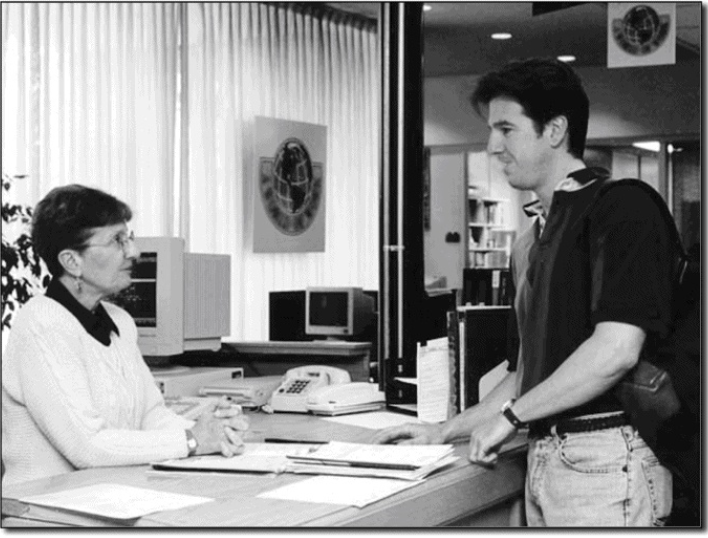
Directions: Now answer the questions.
1. Why does the man need the woman’s assistance? Choose 2 answers.
A. He does not know the publication date of some reviews he needs.
B. He does not know the location of the library’s video collection of plays.
C. He does not know how to find out where the play is currently being performed.
D. He does not know how to determine which newspapers he should look at.
2. What does the woman imply about critical reaction to the play Happy Strangers?
A. Negative critical reaction led to its content being revised after it premiered.
B. The play has always been quite popular among university students.
C. Reactions to the play are more positive nowadays than they were in the past.
D. The play is rarely performed nowadays because critics have never liked it.
3. What does the woman say about her experience seeing a performance of Happy Strangers when she was younger? Choose 2 answers.
A. It was the first play she had seen performed professionally.
B. She saw it against the wishes of her parents.
C. She was surprised at how traditional the performance was.
D. She had a variety of emotional reactions to the play.
4. What is the man’s attitude toward his current assignment?
A. He is not confident that he will find the materials he needs.
B. He feels that performing in a play is less boring than reading one.
C. He thinks his review of the play will be more objective than the contemporary reviews were.
D. He is optimistic that he will learn to appreciate the play he is researching.
5. Listen to Track 2.
A. To ask the man to clarify his request
B. To state the man’s request more precisely
C. To make sure that she heard the man correctly
D. To correct a mistake the man has made
Directions: Listen to Track 3.
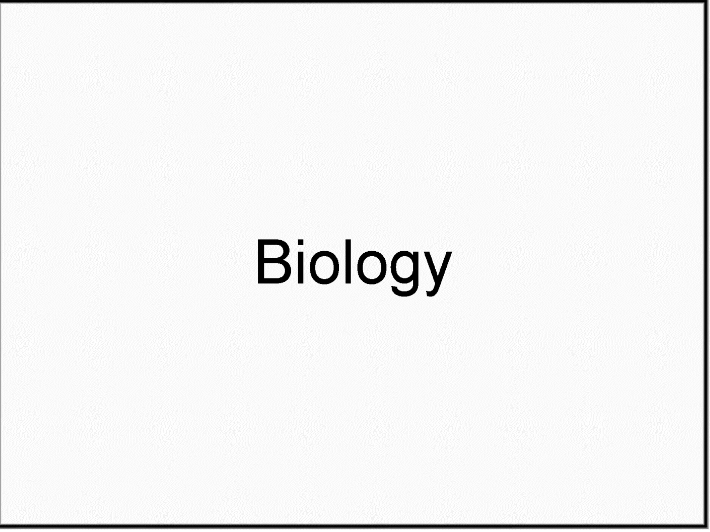
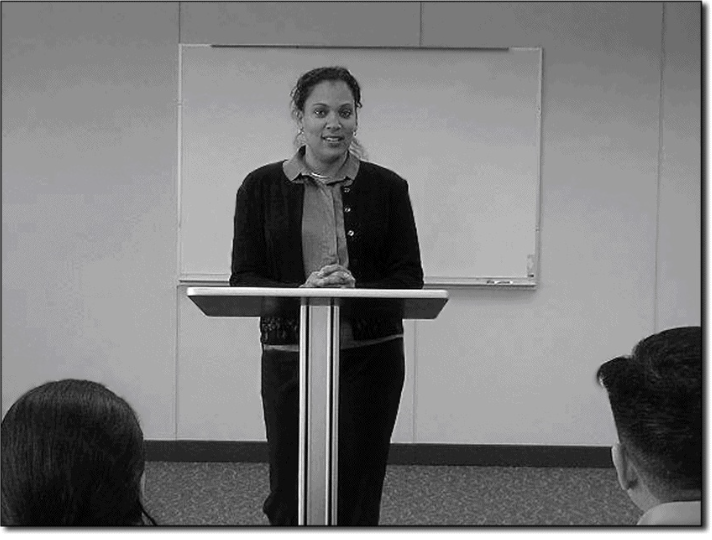

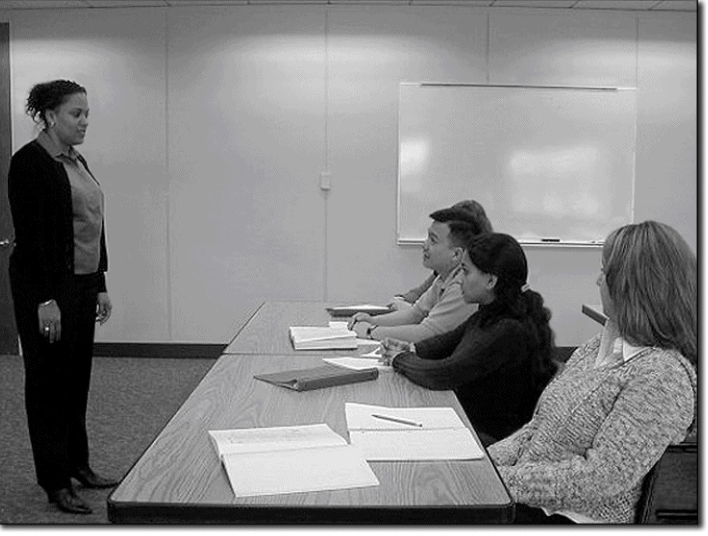

Directions: Now answer the questions.
6. What is the lecture mainly about?
A. Methods of observing unusual animal behavior
B. A theory about ways birds attract mates
C. Ways animals behave when they have conflicting drives
D. Criteria for classifying animal behaviors
7. Indicate whether each of the activities below describes a displacement activity. Put a check (✓) in the correct boxes.

8. What does the professor say about disinhibition?
A. It can prevent displacement activities from occurring.
B. It can cause animals to act on more than one drive at a time.
C. It is not useful for explaining many types of displacement activities.
D. It is responsible for the appearance of seemingly irrelevant behavior.
9. According to the lecture, what is one possible reason that displacement activities are often grooming behaviors?
A. Grooming may cause an enemy or predator to be confused.
B. Grooming is a convenient and accessible behavior.
C. Grooming often occurs before eating and drinking.
D. Grooming is a common social activity.
10. Why does the professor mention the wood thrush?
A. To contrast its displacement activities with those of other animal species
B. To explain that some animals display displacement activities other than grooming
C. To point out how displacement activities are influenced by the environment
D. To give an example of an animal that does not display displacement activities
11. Listen to Track 4.
A. She is impressed by how much the student knows about redirecting.
B. She thinks it is time to move on to the next part of this lecture.
C. The student’s answer is not an example of a displacement activity.
D. The student should suggest a different animal behavior to discuss next.
Directions: Listen to Track 5.
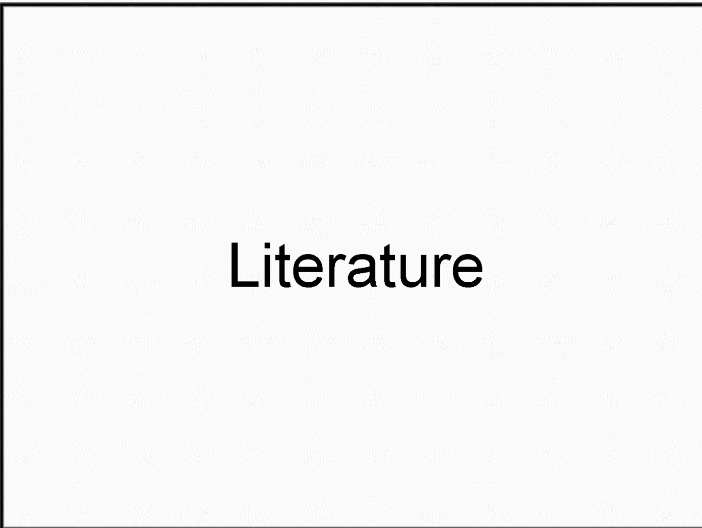

Directions: Now answer the questions.
12. What is the main purpose of the lecture?
A. To point out similarities in Emerson’s essays and poems
B. To prepare the students to read an essay by Emerson
C. To compare Emerson’s concept of universal truth to that of other authors
D. To show the influence of early United States society on Emerson’s writing
13. On what basis did Emerson criticize the people of his time?
A. They refused to recognize universal truths.
B. They did not recognize the genius of certain authors.
C. Their convictions were not well-defined.
D. They were too interested in conformity.
14. What does Emerson say about the past?
A. It should guide a person’s present actions.
B. It must be examined closely.
C. It is less important than the future.
D. It lacks both clarity and universal truth.
15. What point does the professor make when he mentions a ship’s path?
A. It is easy for people to lose sight of their true path.
B. Most people are not capable of deciding which path is best for them.
C. The path a person takes can only be seen clearly after the destination has been reached.
D. A person should establish a goal before deciding which path to take.
16. What does the professor imply about himself when he recounts some life experiences he had before becoming a literature professor? Choose 2 answers.
A. He did not consider the consequences of his decisions.
B. He did not plan to become a literature professor.
C. He has always tried to act consistently.
D. He has trusted in himself and his decisions.
17. Listen to Track 6.
A. To suggest that United States citizens have not changed much over time
B. To encourage the class to find more information about this time period
C. To explain why Emerson’s essay has lost some relevance
D. To provide background for the concept he is explaining
Directions: Listen to Track 7.

Directions: Now answer the questions.
18. What is the conversation mainly about?
A. Methods for finding appropriate sources for a project
B. Reasons the woman is having difficulties with a project
C. Criteria the professor uses to evaluate group projects
D. Ways to develop the skills needed to work in groups
19. Why does the professor mention the “free-rider” problem?
A. To review a concept he explained in class
B. To give the student a plan to solve her problem
C. To clarify the problem the student is facing
D. To explain a benefit of working in groups
20. What is the professor’s opinion of the other students in the woman’s group?
A. They try to take credit for work they did not do.
B. They did not perform well in previous courses with him.
C. They are more motivated when they are working in a group.
D. They do good work when they are interested in the subject.
21. Why did the woman choose property rights as a topic?
A. The professor recommended the topic.
B. She already had a lot of reference materials on the subject.
C. She wanted to learn something new.
D. It was easy to research at the school library.
22. What mistakes does the professor imply the woman has made while working on a project? Choose 2 answers.
A. Finding sources for her group partners
B. Writing the weekly progress reports for her group
C. Forgetting to pay attention to the project’s deadlines
D. Failing to involve the group members in the selection of a topic
Directions: Listen to Track 8.

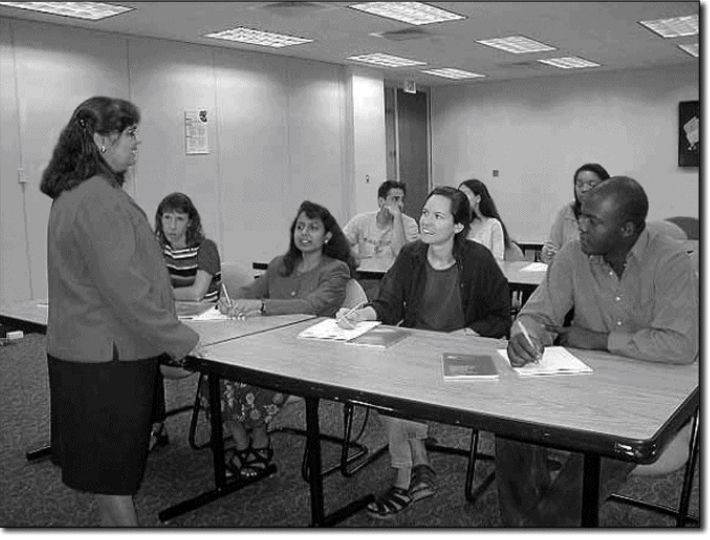

Directions: Now answer the questions.
23. What is the discussion mainly about?
A. Reasons the United States government should not support the arts
B. The history of government support for the arts in the United States
C. Strengths and weaknesses of different government-sponsored arts programs
D. Different ways in which governments can help support artists
24. According to the discussion, in what two ways was the Federal Art Project successful? Choose 2 answers.
A. It established standards for art schools.
B. It provided jobs for many artists.
C. It produced many excellent artists.
D. It gave many people greater access to the arts.
25. The class discusses some important events related to government support for the arts in the United States. Put the events in order from earliest to latest.
Write your answer choices in the spaces where they belong. You can either write the letter of your answer choice or you can copy the sentence. The first one is done for you.
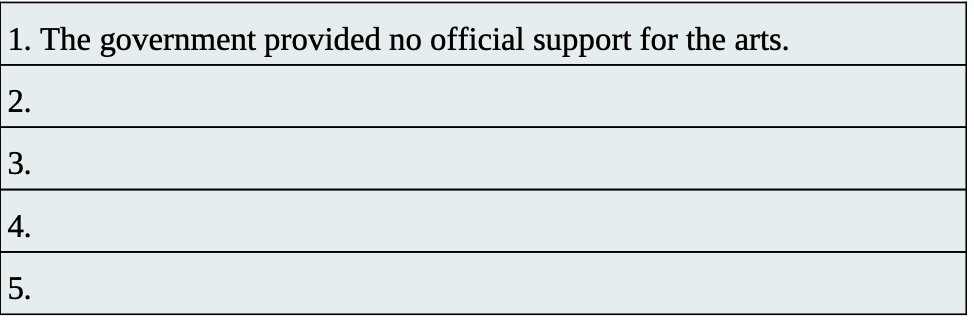
Answer Choices
A. Arts councils were established in all 50 states of the country.
B. The federal budget supporting the arts was reduced by half.
C. The Federal Art Project helped reduce unemployment.
D. The National Endowment for the Arts was established.
26. Why does the professor mention the Kennedy Center and Lincoln Center?
A. To give examples of institutions that benefit from corporate support
B. To illustrate why some artists oppose the building of cultural centers
C. To show how two centers were named after presidents who supported the arts
D. To name two art centers built by the government during the Depression
27. What does the professor say about artists’ opinions of government support for the arts?
A. Most artists believe that the government should provide more funding for the arts.
B. Most artists approve of the ways in which the government supports the arts.
C. Even artists do not agree on whether the government should support the arts.
D. Even artists have a low opinion of government support for the arts.
28. Listen to Track 9.
A. Other students should comment on the man’s remark.
B. Most people would agree with the man’s opinion.
C. Artwork funded by the government is usually of excellent quality.
D. The government project was not a waste of money.
SPEAKING
This section measures your ability to speak in English about a variety of topics.
There are four questions in this section. For each question, you will be given a short time to prepare your response. When the preparation time is up, answer the question as completely as possible in the time indicated for that question. You should record your responses so that you can review them later and compare them with the notes in the Answers section and scoring rubrics.
Listen to Track 10.

2. You will now read a short passage and listen to a conversation on the same topic. You will then be asked a question about them. After you hear the question, give yourself 30 seconds to prepare your response. Then record yourself speaking for 60 seconds.
Listen to Track 11.

Listen to Track 12.

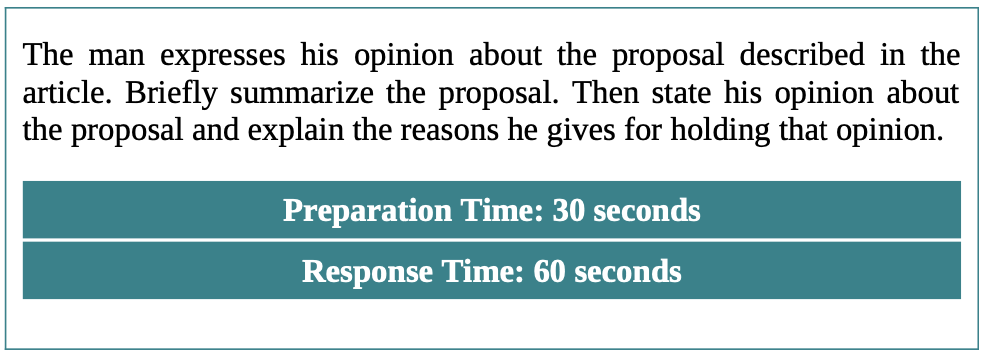
3. You will now read a short passage and listen to a lecture on the same topic. You will then be asked a question about them. After you hear the question, give yourself 30 seconds to prepare your response. Then record yourself speaking for 60 seconds.
Listen to Track 13.

Listen to Track 14.
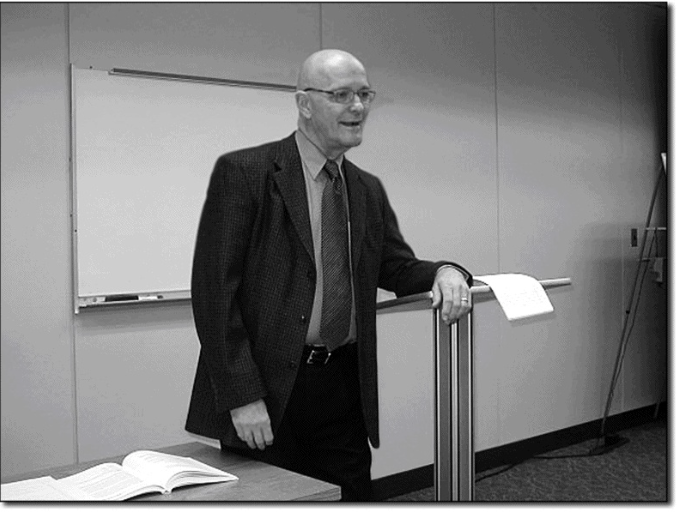
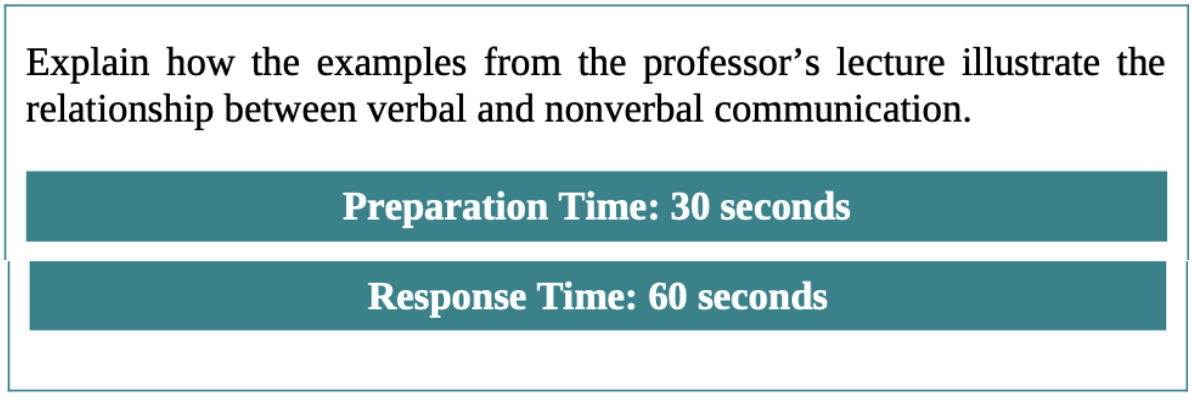
4. You will now listen to part of a lecture. You will then be asked a question about it. After you hear the question, give yourself 20 seconds to prepare your response. Then record yourself speaking for 60 seconds.
Listen to Track 15.
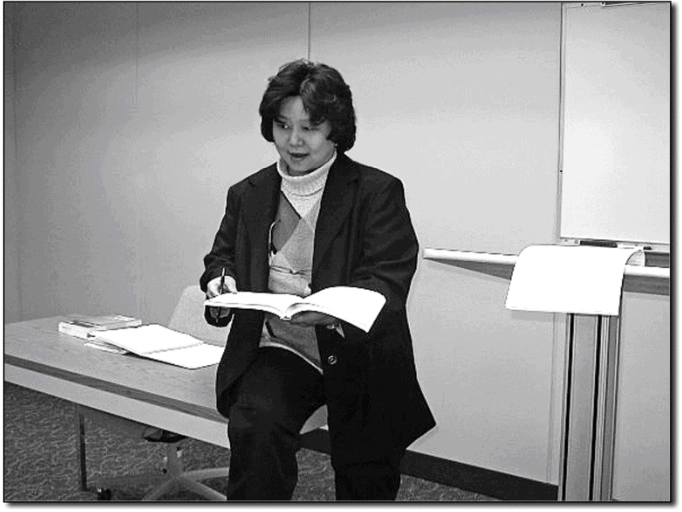

WRITING
This section measures your ability to write in English to communicate in an academic environment.
There are two writing questions in this section.
For question 1, you will read a passage and listen to a lecture about the same topic. You may take notes while you read and listen. Then you will write a response to a question based on what you have read and heard. You may look back at the passage when answering the question. You may use your notes to help you answer the question. You have 20 minutes to plan and write your response.
For question 2, you will write an essay based on your own knowledge and experience. You have 30 minutes to plan and complete your essay.
1. Directions: Give yourself 3 minutes to read the passage.
Endotherms are animals such as modern birds and mammals that keep their body temperatures constant. For instance, humans are endotherms and maintain an internal temperature of 37°C, no matter whether the environment is warm or cold. Because dinosaurs were reptiles, and modern reptiles are not endotherms, it was long assumed that dinosaurs were not endotherms. However, dinosaurs differ in many ways from modern reptiles, and there is now considerable evidence that dinosaurs were, in fact, endotherms.
Polar dinosaurs
One reason for believing that dinosaurs were endotherms is that dinosaur fossils have been discovered in polar regions. Only animals that can maintain a temperature well above that of the surrounding environment could be active in such cold climates.
Leg position and movement
There is a connection between endothermy and the position and movement of the legs. The physiology of endothermy allows sustained physical activity, such as running. But running is efficient only if an animal’s legs are positioned underneath its body, not at the body’s side, as they are for crocodiles and many lizards. The legs of all modern endotherms are underneath the body, and so were the legs of dinosaurs. This strongly suggests that dinosaurs were endotherms.
Haversian canals
There is also a connection between endothermy and bone structure. The bones of endotherms usually include structures called Haversian canals. These canals house nerves and blood vessels that allow the living animal to grow quickly, and rapid body growth is in fact a characteristic of endothermy. The presence of Haversian canals in bone is a strong indicator that the animal is an endotherm, and fossilized bones of dinosaurs are usually dense with Haversian canals.
Listen to Track 16.
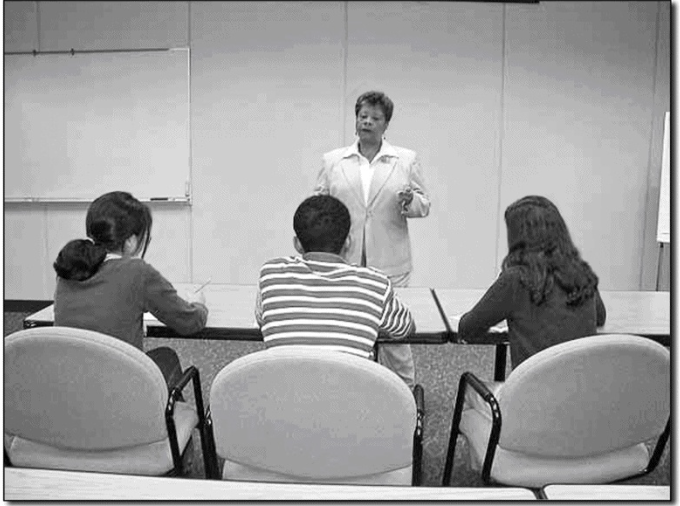
Directions: You have 20 minutes to plan and write your response. Your response will be judged on the basis of the quality of your writing and on how well your response presents the points in the lecture and their relationship to the reading passage. Typically, an effective response will be 150 to 225 words.
Listen to Track 17.
Summarize the points made in the lecture, being sure to explain how they challenge the specific points made in the reading passage.
2. Directions: Read the question below. You have 30 minutes to plan, write, and revise your essay. Typically, an effective response will contain a minimum of 300 words.
Do you agree or disagree with the following statement?
In twenty years there will be fewer cars in use than there are today.
Use specific reasons and examples to support your answer. Be sure to use your own words. Do not use memorized examples.


-340x215.png)
-340x215.png)
-340x215.png)
-340x215.png)



